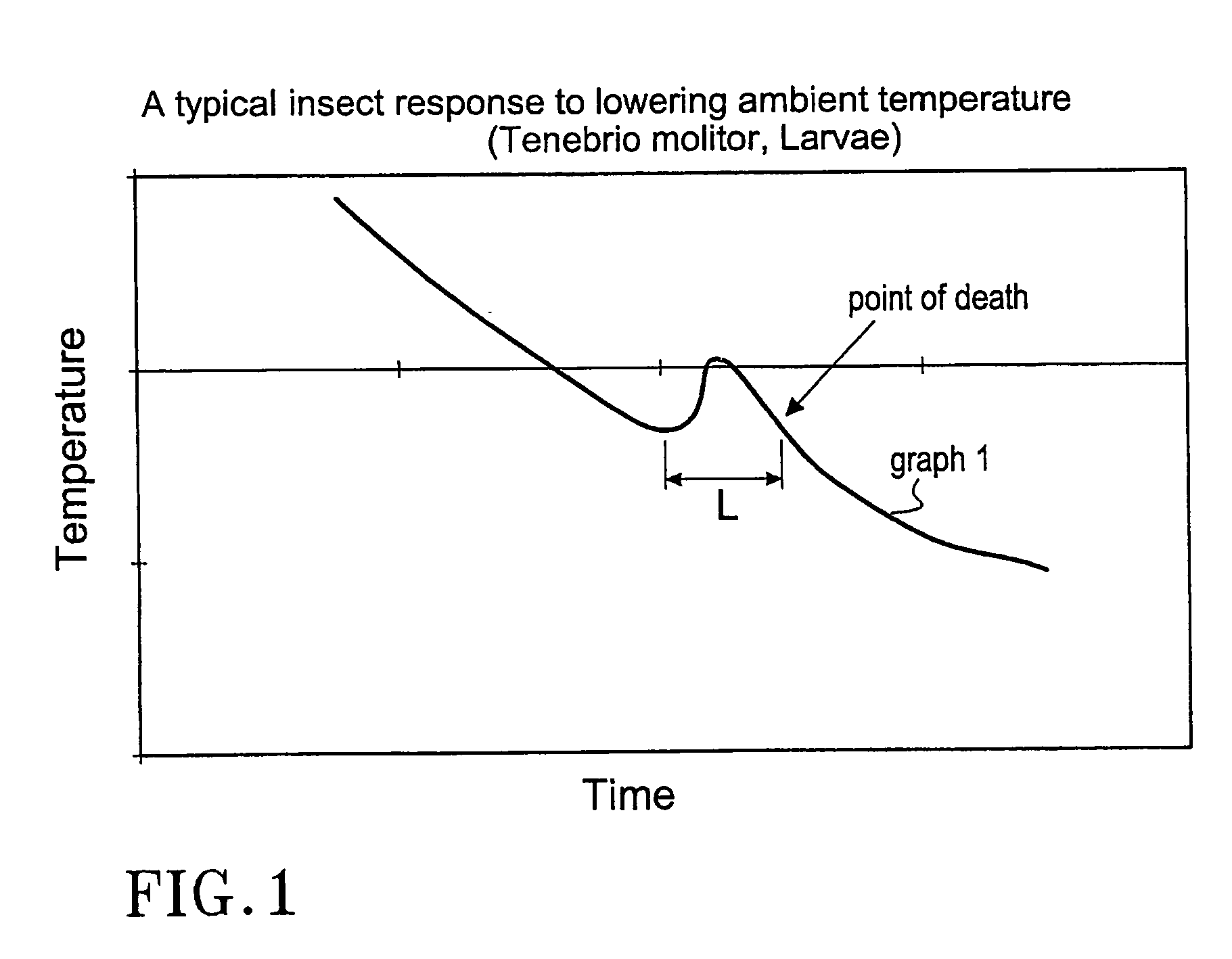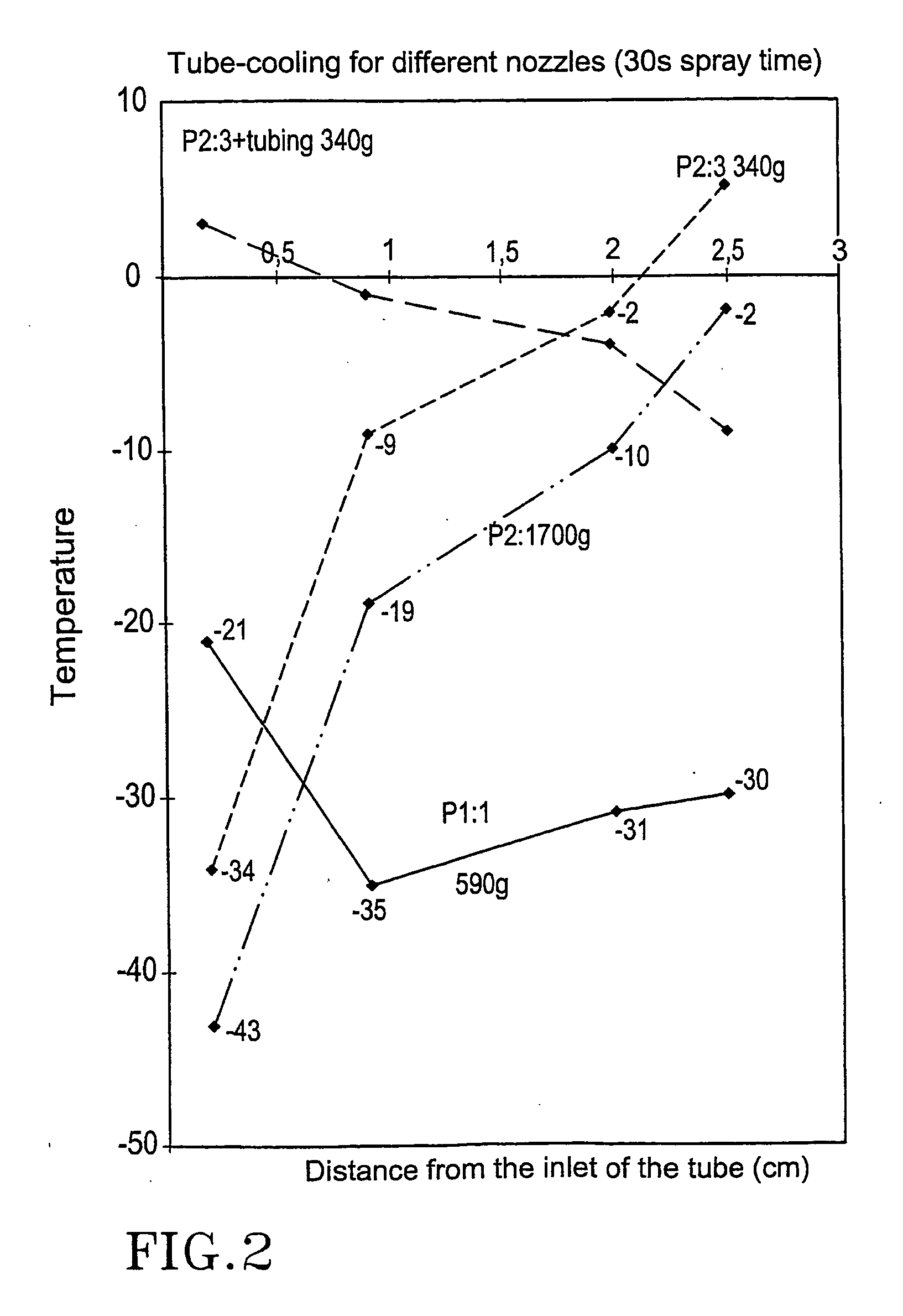Cleaning device and method
a cleaning device and cleaning technology, applied in the direction of spray nozzles, gaseous fuel burners, lighting and heating apparatus, etc., can solve the problems of inability to disinfect areas using conventional methods, degradation products, residual products, allergic reactions, etc., and achieve the effect of effectively exterminating certain kinds of pests
- Summary
- Abstract
- Description
- Claims
- Application Information
AI Technical Summary
Benefits of technology
Problems solved by technology
Method used
Image
Examples
example 1
Tests in a Double Bended Tube of Stainless Steel
[0059] The tube has a internal diameter of 45 mm and a goods thickness of 4 mm. The total length is about 2.5 m. The first 90° bend is located 1.87 m on the tube and the other bend is bended 90° 0.5 m after the first bend. The tube is turned so that the first bend is faced upwards. The thermo elements are brought on plastic pieces on the internal surface exhibiting the distances of 0.215 m and 0.870 m from the inlet of the straight portion of the tube. The third thermo element was brought just after the first bend and the fourth thermo element in the second bend. The thermo elements were denoted K 1, K3, K9 and K11.
[0060] Tables 1-7 below show cooling inside tubes. FIG. 2 is a graph showing cooling inside a tube for the different nozzles at different distances from the opening of the tube. FIG. 5 shows the comparison between a nozzle, P2:3, at different spraying times. Table 1.
TABLE 1Represents cooling inside tubes. Nozzle P1:1. S...
example 2
[0068] Tests in a Wedge.
[0069] Two aluminium panels 400 mm×100 mm are brought against each other as to form a wedge having an opening of 1 mm on top and 0 mm in the bottom. The panel thickness is 1 mm. The panels belly outwards a bit when they are subjected for the pressure of the carbon dioxide. The thermo elements are brought on the surface without contact with the panel in recessed holes 3 mm. The lower and the upper measure point are brought 5 mm from the respective edge and the third in the middle. The measure points are denoted K1, K3 and K9 from the surface to the bottom.
[0070] The Tables 8-11 below show cooling in a wedge. FIG. 3 is a graph showing cooling in a wedge for the different nozzles at different depths in said wedge.
TABLE 8Cooling in a wedge. Nozzle P1:1. Distance 60 mm, from theside. The wedge is mounted having its longitudinal axis verticallyarranged. Spraying time 3 seconds. Starting temperatureapprox. 25° C. Amount of gas 59 g.TemperatureMeasureMinimumchang...
example 3
Tests on a Planar Surface.
[0075] An aluminium panel having the dimensions of 30×30×0.5 mm was provided with a thermo element that was adhesively joined to the surface in one of the corners. The panel was heat insulated by applying a cell rubber tape on the back.
[0076] The Tables 12-15 show cooling on a planar surface. The cooling effect for different kinds of nozzles on different distances from the target. Table 16 shows cooling of a planar surface. Same nozzle but at different spraying times. FIG. 4 is a graph showing cooling on a planar surface for the different nozzles at different distances from said nozzle and the planar surface.
TABLE 12Cooling on a planar surface. Nozzle P2: 3. Distance 1, 5, 10, 15,20, 30 and 40 cm. Spraying time 3 s. Target: isolated aluminiumpanel. Starting temperature about 25° C. before a newapplication. Used amount of gas 34 g.Distance nozzle-Obtained minimumTemperature° C. / usedtarget (cm)temperature ° C.changeamount of gas (g)1−46712.085−30551.6110...
PUM
| Property | Measurement | Unit |
|---|---|---|
| particle size | aaaaa | aaaaa |
| particle size | aaaaa | aaaaa |
| particle velocity | aaaaa | aaaaa |
Abstract
Description
Claims
Application Information
 Login to View More
Login to View More - R&D
- Intellectual Property
- Life Sciences
- Materials
- Tech Scout
- Unparalleled Data Quality
- Higher Quality Content
- 60% Fewer Hallucinations
Browse by: Latest US Patents, China's latest patents, Technical Efficacy Thesaurus, Application Domain, Technology Topic, Popular Technical Reports.
© 2025 PatSnap. All rights reserved.Legal|Privacy policy|Modern Slavery Act Transparency Statement|Sitemap|About US| Contact US: help@patsnap.com



